Balbharti Maharashtra State Board Class 12 Sociology Solutions
Chapter 4 Processes of Social Change in India Textbook Exercise Questions and Answers.
1A. Complete the following statements by choosing the correct alternative given in the brackets and rewrite it.
Question 1.
The use of computers to streamline job applications is called __________ (industrialization, globalisation, digitalization)
Answer:
digitalization

Question 2.
An urban way of life is characterized by __________ (cohesiveness, uniformity, impersonality)
Answer:
impersonality
1B. Correct the incorrect pair and rewrite it.
Question 1.
(a) Copying western culture – Modernisation
(b) Growth of cities – Urbanisation
(c) Increase in production – Industrialisation
(d) Radical transformative use of technology – Digitalisation
Answer:
(a) Copying western culture – Westernisation
1C. Identify the appropriate term from the given options in the box and rewrite it against the given statement.
Urbanism, Industrialisation, Digitalisation
Question 1.
The FYJC On-line Admission process in metropolitan cities.
Answer:
Digitalisation
Question 2.
Mechanisation of the process of production.
Answer:
Industrialisation
1D. Correct the underlined words and complete the statement.
Question 1.
The Industrial Revolution took place in the sixteenth century.
Answer:
The Industrial Revolution took place in the 17th and 18th centuries.

Question 2.
The LPG Policy was started by Smt. Indira Gandhi.
Answer:
The LPG Policy was started by Dr. Manmohan Singh.
2. Write short notes.
Question 1.
Negative effects of digitalisation
Answer:
Question 2.
Consequences of Industrialisation
Answer:
3. Write differences.
Question 1.
Industrialisation and Urbanisation
Answer:
Question 2.
Modernisation and Globalisation
Answer:
4. Explain the following concepts with examples.
Question 1.
Digitalisation
Answer:

Question 2.
Urbanisation
Answer:
5A. Complete the concept map.
Question 1.

Answer:

5B. State whether the following statements are True or False with reasons.
Question 1.
The clothes one wears are indicative of an individual’s level of modernization.
Answer:
This statement is False.

Question 2.
Urbanisation can have negative effects on our social relationships.
Answer:
This statement is True.
6. Give your personal response.
Question 1.
Shagufta Ranawat and her joint family have been living in Nagpur city for almost three generations. Their grandchildren are uninclined to want to settle down in their grandparent’s village. Give two possible reasons for the grandchildren’s view.
Answer:
1st View: As Shagufta Ranawat and her family from last three generations living in Nagpur city. Nagpur is one of the mega metro cities of India which is loaded with full of infrastructural facilities as well as employment opportunities, gender equality even through materialistic approach it has a rational and scientific outlook. So, grandchildren don’t want to leave Nagpur city and settle down in the village.
2nd View: Grandchildren know that now grandparents are age-old and advanced medical facilities will not be easily available during emergencies. So for precautionary measure of grandparent’s health, living in Nagpur city which is a well-developed hub is good for them.
Question 2.
Some people feel insecure about digitalisation processes, for example, in banking or online purchasing. Why do you think this is the case?
Answer:
Yes, some people feel insecure about digitalisation processes because of being computer phobic or computer illiterate, as they don’t trust the internet and perceived security risks. The perception that someone else has access to your bank account is a deal-breaker for many. It’s a big jump into the unknown with your hard-earned money especially if you have no one to explain it to you.
7. Answer the following question in detail. (About 150-200 words)
Question 1.
“The World Wide Web is a source of information and misinformation”. Discuss this statement with regard to the impact of the internet on:
(i) Parents
(ii) Children
(iii) School
Answer:
(i) Impact of the Internet on Parents:

(ii) Impact of the Internet on Children:
(iii) Impact of the Internet on School:
Activity 1 (Textbook Page No. 59)
Identify any four cities and study data about their industrial growth. Presents your findings to your class and follows them with a discussion.
Answer:
(i) Industrial growth in Mumbai:
(ii) Industrial growth in Pune:
(iii) Industrial growth in Nagpur:
(iv) Industrial growth in Kolkata:
Activity 2 (Textbook Page No. 60)
Get 4 volunteers from your class to share their experiences (physical environment, economic life, customs, food, religious practices etc.) in a rural village or city, in 5-7 minutes each. They may make a PPT with visuals to support their presentations. Follow up with a class discussion.
Answer:
Activity 3 (Textbook Page No. 62)
Conduct a 2-minute extempore speech competition in class on the topic: “Modernisation may be perceived as a challenge in a traditional society.”
Answer:
The following pointers will help you prepare a speech.

Activity 4 (Textbook Page No. 63)
Given below is a way of finding out about people’s lives. It is called narrative research. It is all about hearing people’s stories.
Few volunteers from your class may speak to 1-2 small shops in the area and find out about their business. When did it start? Who started it? Are there changes in their sales? Are there changes in people’s behaviour? Are there any problems faced by the sellers? If so, what are they?
Write about their stories in about 200-300 words. Share with your class. See if you can see a pattern of experience or behaviour.
Answer:
The below example will provide you with pointers for your own narrative research.
Activity 5 (Textbook Page No. 65)
Identify any three Higher Secondary School teachers in your locality or school. Collect information about (a) the subject they teach, (b) their qualifications (e) number of years of teaching experience, (d) whether they have computers in their school/college, (e) whether they use computers and if yes, for what purpose? Report your findings in class.
Answer:
Activity 6 (Textbook Page No. 65)
‘Globalisation has a positive effect on Indian society.’ Form two teams of four students each, and conduct a class debate. The teacher may prepare a blackboard summary of the learning points. It can be followed by an open discussion of observations made by students.
Answer:
(i) Globalisation has a positive effect on Indian Society: (Debate 1st side)
(ii) Globalisation has a negative effect on Indian Society: (Debate 2nd side)

Activity 7 (Textbook Page No. 67)
Hold a class discussion at the end of each process of change, to discuss the positive and negative impact of each process. Develop a flow chart or concept map for each process of social change.
Answer:






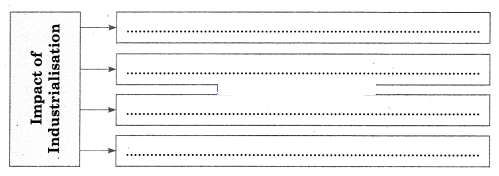




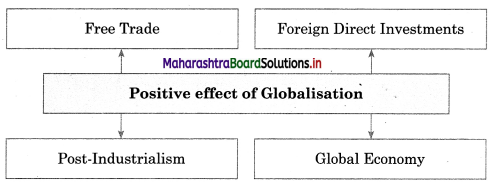
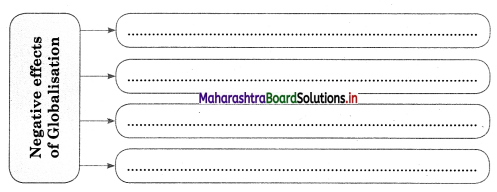
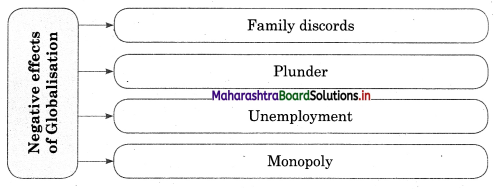
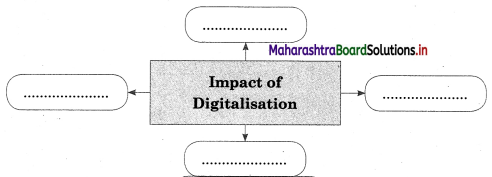
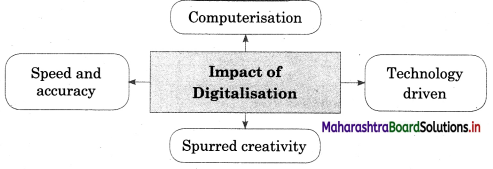




Chapter 4 Processes of Social Change in India Textbook Exercise Questions and Answers.
1A. Complete the following statements by choosing the correct alternative given in the brackets and rewrite it.
Question 1.
The use of computers to streamline job applications is called __________ (industrialization, globalisation, digitalization)
Answer:
digitalization

Question 2.
An urban way of life is characterized by __________ (cohesiveness, uniformity, impersonality)
Answer:
impersonality
1B. Correct the incorrect pair and rewrite it.
Question 1.
(a) Copying western culture – Modernisation
(b) Growth of cities – Urbanisation
(c) Increase in production – Industrialisation
(d) Radical transformative use of technology – Digitalisation
Answer:
(a) Copying western culture – Westernisation
1C. Identify the appropriate term from the given options in the box and rewrite it against the given statement.
Urbanism, Industrialisation, Digitalisation
Question 1.
The FYJC On-line Admission process in metropolitan cities.
Answer:
Digitalisation
Question 2.
Mechanisation of the process of production.
Answer:
Industrialisation
1D. Correct the underlined words and complete the statement.
Question 1.
The Industrial Revolution took place in the sixteenth century.
Answer:
The Industrial Revolution took place in the 17th and 18th centuries.

Question 2.
The LPG Policy was started by Smt. Indira Gandhi.
Answer:
The LPG Policy was started by Dr. Manmohan Singh.
2. Write short notes.
Question 1.
Negative effects of digitalisation
Answer:
Question 2.
Consequences of Industrialisation
Answer:
3. Write differences.
Question 1.
Industrialisation and Urbanisation
Answer:
| Industrialisation | Urbanisation |
| (i) Meaning: It means the use of unbiotic power such as electricity and steam for the mass production of goods. | (i) Meaning: Urbanisation consists of an inward flow of a large number of people from scattered rural areas to urban communities. |
| (ii) Origin: Industrialization started in England due to the impact of the industrial revolution. | (ii) Origin: Urbanization is the consequence of industrialization. |
| (iii) Nature: Industrialisation reflects mechanisation of workplaces and spurt in the growth of factories and industries. | (iii) Nature: Urbanisation reflects the migration of people from all over the country continuously, in search of work. |
| (iv) Characteristics: The adoption of the revolutionary changes occurred in the production system i.e. use of heavy machinery and automation. | (iv) Characteristics: The adoption of the civil administration like law and city police for the urban area. |
| (v) Impact: Due to industrialisation impact of scientific and technical knowledge has been increasing. So, people are accepting rationalism and secularism. | (v) Impact: Due to urbanisation, the traditional belief system has been changed and become more secular in their outlooks, new educational fields are created in cities. |
| (vi) Effect: Industrialisation has led to the breakdown of joint families and the shrinking size of families. | (vi) Effect: Urbanisation has led to the notion of being “lonely in a crowd”. |
Modernisation and Globalisation
Answer:
| Modernisation | Globalisation |
| (i) Meaning: “Modernisation is the current term of an old process of social change whereby less developed societies acquire the characteristics common to more developed societies.” | (i) Meaning: Globalisation refers to “all those processes by which the people of the world are incorporated into a single world society.” |
| (ii) Characteristics: Modernisation reflects a rational outlook and scientific temperament and discarding traditional ways as these hinder the progress of the society. | (ii) Characteristics: Globalisation reflects the new economic policy means LPG policy which opens the door for the Indian economy and India became part of a wider global economy. |
| (iii) Manifestations: The adoption of the progressive ideas of the developed countries such as industrialisation and computerisation are its manifestations. | (iii) Manifestations: It leads to the transfer of resources, goods, and capital across the country. |
| (iv) Impact: Modernisation in every walk of life has contributed to the material progress of society and the well-being of individuals. | (iv) Impact: Globalisation has promoted industrialisation, expanded market, increase export as well as export area. Globalisation has created various new opportunities of employment. |
Question 1.
Digitalisation
Answer:

Question 2.
Urbanisation
Answer:
5A. Complete the concept map.
Question 1.

Answer:

5B. State whether the following statements are True or False with reasons.
Question 1.
The clothes one wears are indicative of an individual’s level of modernization.
Answer:
This statement is False.

Question 2.
Urbanisation can have negative effects on our social relationships.
Answer:
This statement is True.
6. Give your personal response.
Question 1.
Shagufta Ranawat and her joint family have been living in Nagpur city for almost three generations. Their grandchildren are uninclined to want to settle down in their grandparent’s village. Give two possible reasons for the grandchildren’s view.
Answer:
1st View: As Shagufta Ranawat and her family from last three generations living in Nagpur city. Nagpur is one of the mega metro cities of India which is loaded with full of infrastructural facilities as well as employment opportunities, gender equality even through materialistic approach it has a rational and scientific outlook. So, grandchildren don’t want to leave Nagpur city and settle down in the village.
2nd View: Grandchildren know that now grandparents are age-old and advanced medical facilities will not be easily available during emergencies. So for precautionary measure of grandparent’s health, living in Nagpur city which is a well-developed hub is good for them.
Question 2.
Some people feel insecure about digitalisation processes, for example, in banking or online purchasing. Why do you think this is the case?
Answer:
Yes, some people feel insecure about digitalisation processes because of being computer phobic or computer illiterate, as they don’t trust the internet and perceived security risks. The perception that someone else has access to your bank account is a deal-breaker for many. It’s a big jump into the unknown with your hard-earned money especially if you have no one to explain it to you.
7. Answer the following question in detail. (About 150-200 words)
Question 1.
“The World Wide Web is a source of information and misinformation”. Discuss this statement with regard to the impact of the internet on:
(i) Parents
(ii) Children
(iii) School
Answer:
(i) Impact of the Internet on Parents:

(ii) Impact of the Internet on Children:
(iii) Impact of the Internet on School:
Activity 1 (Textbook Page No. 59)
Identify any four cities and study data about their industrial growth. Presents your findings to your class and follows them with a discussion.
Answer:
(i) Industrial growth in Mumbai:
(ii) Industrial growth in Pune:
(iii) Industrial growth in Nagpur:
(iv) Industrial growth in Kolkata:
Activity 2 (Textbook Page No. 60)
Get 4 volunteers from your class to share their experiences (physical environment, economic life, customs, food, religious practices etc.) in a rural village or city, in 5-7 minutes each. They may make a PPT with visuals to support their presentations. Follow up with a class discussion.
Answer:
| Volunteer – 1 Village – Khed, Junnar Taluka |
Volunteer – 2 Village – Ghodegaon, Manchar Taluka |
Volunteer – 3 City – Pune |
Volunteer – 4 City – Mumbai |
|
| Physical Environment | Clean, pure, and healthy air | Clean, pure and healthy air | Pollution and overcrowded | Pollution and shortage of land |
| Economic Life | Agrarian (Poor) | Agrarian and domestic business | Industry and factory oriented (Rich) | Industrialisation (Rich) |
| Customs | Traditional and superstition bound | Tradition and superstition bound | The rational and scientific perspective | Follow the customs rationally |
| Food | Jawar, wheat, rice (Homemade) | Staple food | Materialistic approach | Materialistic view |
| Religious practices | Follow judiciously and blindly | Follow blindly | Modern/critical thinking | Modern/critical thinking |
Conduct a 2-minute extempore speech competition in class on the topic: “Modernisation may be perceived as a challenge in a traditional society.”
Answer:
The following pointers will help you prepare a speech.

Activity 4 (Textbook Page No. 63)
Given below is a way of finding out about people’s lives. It is called narrative research. It is all about hearing people’s stories.
Few volunteers from your class may speak to 1-2 small shops in the area and find out about their business. When did it start? Who started it? Are there changes in their sales? Are there changes in people’s behaviour? Are there any problems faced by the sellers? If so, what are they?
Write about their stories in about 200-300 words. Share with your class. See if you can see a pattern of experience or behaviour.
Answer:
The below example will provide you with pointers for your own narrative research.
Activity 5 (Textbook Page No. 65)
Identify any three Higher Secondary School teachers in your locality or school. Collect information about (a) the subject they teach, (b) their qualifications (e) number of years of teaching experience, (d) whether they have computers in their school/college, (e) whether they use computers and if yes, for what purpose? Report your findings in class.
Answer:
| Questions | Teacher – 1 (Ms. L) | Teacher – 2 (Ms. M) | Teacher – 3 (Mr. X) |
| The subject they teach | English | History | Marathi |
| Qualification | M.A, B.Ed., M.Phil. (Eng.) | M.A., B.Ed. (History) | M.A., B.Ed. (Mar.) |
| Teaching experience | 5 Years | 10 Years | 9 Years |
| Whether they have computers in school/college | Yes | Yes | Yes |
| Whether they use computers and if yes, for what? | Yes, for preparation of notes, questions papers, research work, and references. | Yes, for making notes. | Yes, for making notes. |
‘Globalisation has a positive effect on Indian society.’ Form two teams of four students each, and conduct a class debate. The teacher may prepare a blackboard summary of the learning points. It can be followed by an open discussion of observations made by students.
Answer:
(i) Globalisation has a positive effect on Indian Society: (Debate 1st side)
(ii) Globalisation has a negative effect on Indian Society: (Debate 2nd side)

Activity 7 (Textbook Page No. 67)
Hold a class discussion at the end of each process of change, to discuss the positive and negative impact of each process. Develop a flow chart or concept map for each process of social change.
Answer:



















